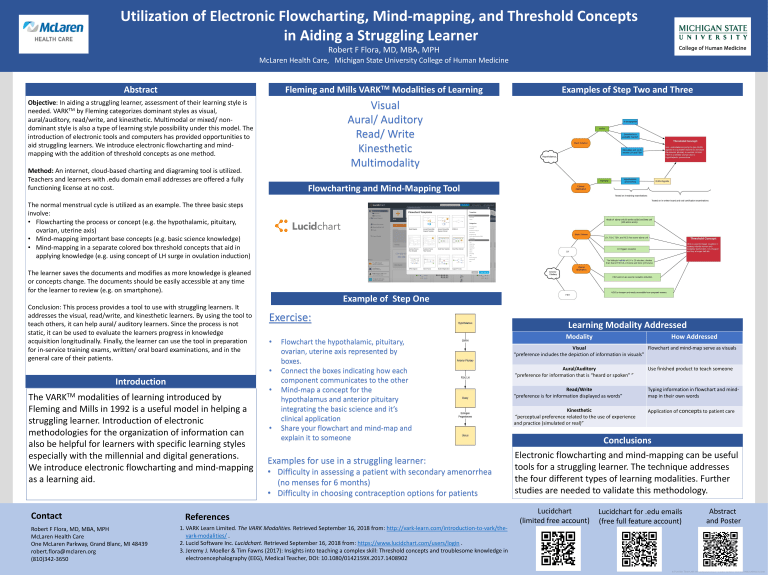
Utilization of Electronic Flowcharting, Mind-mapping, and Threshold Concepts in Aiding a Struggling Learner Robert F Flora, MD, MBA, MPH McLaren Health Care, Michigan State University College of Human Medicine Abstract Fleming and Mills VARKTM Modalities of Learning Objective: In aiding a struggling learner, assessment of their learning style is needed. VARKTM by Fleming categorizes dominant styles as visual, aural/auditory, read/write, and kinesthetic. Multimodal or mixed/ nondominant style is also a type of learning style possibility under this model. The introduction of electronic tools and computers has provided opportunities to aid struggling learners. We introduce electronic flowcharting and mindmapping with the addition of threshold concepts as one method. Visual Aural/ Auditory Read/ Write Kinesthetic Multimodality Method: An internet, cloud-based charting and diagraming tool is utilized. Teachers and learners with .edu domain email addresses are offered a fully functioning license at no cost. Examples of Step Two and Three Flowcharting and Mind-Mapping Tool The normal menstrual cycle is utilized as an example. The three basic steps involve: • Flowcharting the process or concept (e.g. the hypothalamic, pituitary, ovarian, uterine axis) • Mind-mapping important base concepts (e.g. basic science knowledge) • Mind-mapping in a separate colored box threshold concepts that aid in applying knowledge (e.g. using concept of LH surge in ovulation induction) The learner saves the documents and modifies as more knowledge is gleaned or concepts change. The documents should be easily accessible at any time for the learner to review (e.g. on smartphone). Conclusion: This process provides a tool to use with struggling learners. It addresses the visual, read/write, and kinesthetic learners. By using the tool to teach others, it can help aural/ auditory learners. Since the process is not static, it can be used to evaluate the learners progress in knowledge acquisition longitudinally. Finally, the learner can use the tool in preparation for in-service training exams, written/ oral board examinations, and in the general care of their patients. Example of Step One Exercise: • • Introduction TM VARK The modalities of learning introduced by Fleming and Mills in 1992 is a useful model in helping a struggling learner. Introduction of electronic methodologies for the organization of information can also be helpful for learners with specific learning styles especially with the millennial and digital generations. We introduce electronic flowcharting and mind-mapping as a learning aid. Contact Robert F Flora, MD, MBA, MPH McLaren Health Care One McLaren Parkway, Grand Blanc, MI 48439 robert.flora@mclaren.org (810)342-3650 • • Flowchart the hypothalamic, pituitary, ovarian, uterine axis represented by boxes. Connect the boxes indicating how each component communicates to the other Mind-map a concept for the hypothalamus and anterior pituitary integrating the basic science and it’s clinical application Share your flowchart and mind-map and explain it to someone Examples for use in a struggling learner: • Difficulty in assessing a patient with secondary amenorrhea (no menses for 6 months) • Difficulty in choosing contraception options for patients References 1. VARK Learn Limited. The VARK Modalities. Retrieved September 16, 2018 from: http://vark-learn.com/introduction-to-vark/thevark-modalities/ . 2. Lucid Software Inc. Lucidchart. Retrieved September 16, 2018 from: https://www.lucidchart.com/users/login . 3. Jeremy J. Moeller & Tim Fawns (2017): Insights into teaching a complex skill: Threshold concepts and troublesome knowledge in electroencephalography (EEG), Medical Teacher, DOI: 10.1080/0142159X.2017.1408902 Learning Modality Addressed Modality How Addressed Visual Flowchart and mind-map serve as visuals “preference includes the depiction of information in visuals” Aural/Auditory ”preference for information that is “heard or spoken” ” Use finished product to teach someone Read/Write “preference is for information displayed as words” Typing information in flowchart and mindmap in their own words Kinesthetic “perceptual preference related to the use of experience and practice (simulated or real)” Application of concepts to patient care Conclusions Electronic flowcharting and mind-mapping can be useful tools for a struggling learner. The technique addresses the four different types of learning modalities. Further studies are needed to validate this methodology. Lucidchart (limited free account) Lucidchart for .edu emails (free full feature account) Abstract and Poster

